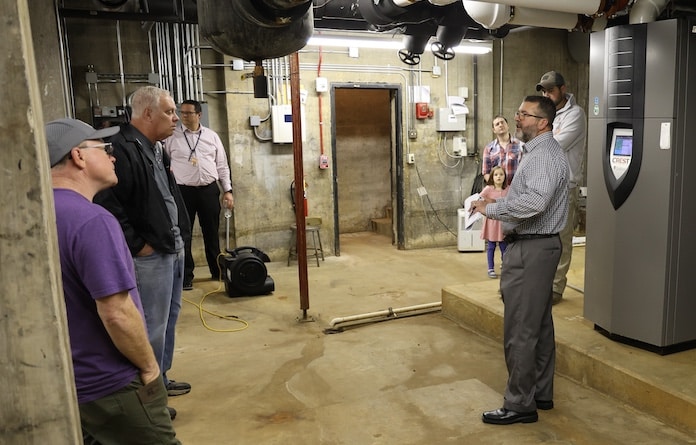WJHS tour shows trouble

The Waterloo School District hosted two tours of Waterloo Junior High School last week to encourage feedback from community members regarding the future of the aging facility.
With notably small turnout, it seems the Waterloo School Board still has plenty of discussion and consideration to do as it decides whether to renovate the current building or pursue construction on a new structure over the next few years.
The tours took place Thursday evening and Saturday morning, with Waterloo Superintendent of Schools Brian Charron joined by several district and junior high administration and staff.
On Thursday, Charron led a small group of locals around WJHS, highlighting the current state of various rooms and features of the building.
The most poignant parts of the tour were largely in the original wing of the building to the north.
In particular, community members on the tour visited the boiler room in the basement and though the space was dry this time, Charron emphasized flooding issues that room has seen when it rains, with water pooling throughout the space and not infrequently threatening to reach the boilers.
Upstairs, guests could see a cannibalized ventilation unit in one of the building’s unused rooms.
As has been previously discussed at school board meetings, these units in empty classrooms have been stripped of parts in order to repair the units in classrooms used as the required parts can no longer be found given the age of the HVAC system.
Walking around the building, particularly in the north wing, Charron highlighted the narrow hallways and staircases that lead to congestion issues every day as roughly 600 students jostle one another going from class to class.
In the space between the original and renovated parts of the building, the floor is marked to try and direct traffic. Similarly, in the north wing, students are required to use one staircase to ascend to the second floor and a separate staircase to go back down.
Another stop was the gym located in the part of the school constructed in 1956, as Charron noted how sound and functional the gym and the renovated half of that school is.
He also pointed to the gym’s bleachers, specifically the hand-railing lined with plexiglass that was installed fairly recently. Charron noted the district originally wanted to simply have bars welded into the railing to fill large gaps that could be dangerous for small children, but such a substantial change meant the railing would need to be brought up to code, necessitating that code-compliant and more expensive plexiglass be installed instead.
Charron used this as an example of the junior high’s current situation, noting that improving a certain amount of the decades-old structure would mean having to bring the full facility up to current code at the same time.
The group also stepped into one of the locker rooms, with Charron noting exposed pipes overhead. He mentioned how that particular feature can be worrisome as it’s almost inevitable for a group of boys in the locker room to wind up trying to hang from the pipes when unsupervised.
Before and after the tour, attendees gathered in the cafeteria for discussion, with Charron providing a rundown of the district’s junior high predicament.
He explained that the talk of renovation versus replacement came about primarily due to HVAC needs.
“That heating and cooling system was really the catalyst for this conversation because they’re estimating it’s gonna be between five and six million dollars to replace the heating and cooling system,” Charron said. “When we started talking about that, it was, ‘Well, if we’re gonna replace the heating and cooling system and open up walls in every classroom and have to be running new lines to those, we should probably take care of the main waterlines that are going to restrooms, water fountains, et cetera… and while we’ve got the walls opened up under windows, probably ought to replace windows.’”
Charron further discussed the range of other issues the current building faces. From an aging electrical system to pipes that have rusted to the point of breaking down – he showed one such elbow joint with a substantial hole in it that was previously replaced – many of these issues have been discussed among the school board.
He went on to speak about how the district and its consulted architects have been weighing the costs and benefits of overhauling the current building or doing a patch job to deal with safety issues before pursuing an entirely new structure.
“They’re anticipating that over 25 to 30 years, we will spend approximately $42-49 million on this building,” Charron said. “We also did a comparison of what it would cost to build a new building, including acquiring the land, all the geographic studies that would have to be done, adding in intersections, lights, anything associated with getting access to that, and that could run upward of $90 million based on estimates they have.”
Beyond safety and upkeep, Charron also noted there are a range of improvements school staff and faculty would like to see, such as fiber internet.
“If we make that investment in this building for another 25-30 years, we want to do some other upgrades and make this building something that people are proud of for 30 years,” Charron said. “We don’t want it to be just the patchwork of those major things.”
Among the few guests in attendance, Charron fielded some questions, many of them entertaining the possibility of a new building.
Some asked where a new facility would be located, what would be done with the abandoned school and how parking would be managed. In responding, Charron noted how early in this process the district really is, with much of these matters still being up in the air as the cost and community interest in either project is still being gauged.
As the tour wound down, Charron addressed those in attendance to reiterate the need for change in the school.
“We do have to spend some money. Not spending money is not an option,” Charron said. “We either have to commit to this building – and it’s a 25, 30 year commitment to making it something Waterloo would be proud of – or it’s give up on this building, make plans for 3-5 years from now to be moving into a new building in a different location and have all those discussions.”
Charron also touched on some potential alternatives to a full renovation or replacement, suggesting it could be possible to renovate the school as needed and then replace the oldest part of the building.
He ultimately spoke to his hopes to satisfy Waterloo residents of the future.
“I do think that, if we renovate this building, that gives us 30 years to figure out what are we gonna do with the north end,” Charron said. “At that point, I think it would be time to let go of the north end and then decide whether we could get another 30 years out of this one. But I’m 113 years old at that point, so who cares what I think. We’re just trying to make that best decision now that people are, whether they’re happy about it or not, I hope the community respects the fact that we’re taking our time.”
One of the school’s administrators who was present for the tour was WJHS Assistant Principal Cara Brown, who spoke with the Republic-Times to describe her experience with this building.
Brown’s history with the facility stretches more than 25 years, as she started there in 1998 when it was still the combined high school and junior high.
She stuck around teaching as the new junior high – which has since come to be Gardner Elementary – was constructed, though she jumped to the current high school when it was built.
Brown has returned to the building in the years since to serve as assistant principal, and she pointed to a number of problems she and her coworkers have experienced throughout her time at the junior high.
“For sure the heating and cooling is an issue,” Brown said. “The fact that we have the inability to get parts for what we currently have, so there are parts of the building that can’t be used.”
She further spoke on health and safety, voicing concern about humidity and other such issues posed by spaces like the boiler room having standing water much of the time.
Brown also echoed Charron’s sentiment regarding the school’s pipes, voicing concern about how that damaged, corroded plumbing supplies the school’s water fountains and other essentials.
She additionally touched on the issue of space in the school’s hallways and brought up concerns about safety, noting how the current state of the WJHS main entrance and other doors are a far cry from what is seen in schools built nowadays.
“Safety is a huge one for me, just wanting to make sure that we have the safest building possible,” Brown said. “I think that our current building has way too many entrances and exits. New buildings today would never have so many possible places for people to come in and go out. Also having a more secure entryway, whether we were to do a new building or renovate this one.”
Speaking with the Republic-Times following the Saturday tour, Charron said attendance for the morning event was similarly sparse.
He suggested community members would likely be more invested in participating in such tours and offering their input were a project to be further along. He indicated that having such a decision as a pending referendum item might help spur interest.
Charron also addressed the online survey the district is conducting on the matter, saying that, as of Monday afternoon, 21 individuals have offered input.
While not all left detailed comments, 13 endorsed a new building, five were interested in renovating the current building and three were undecided or ambivalent.
With these numbers hardly being indicative of the entire community, Charron reiterated the school board’s interest in receiving public input.
Those interested in filling out the aforementioned survey can still do so through a link available on the district’s Facebook page.






